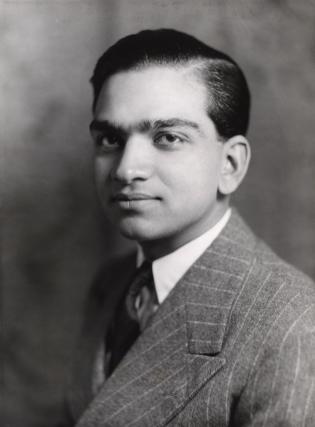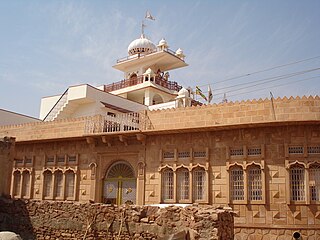
Rajasthan is a state in northern India. It covers 342,239 square kilometres (132,139 sq mi) or 10.4 per cent of India's total geographical area. It is the largest Indian state by area and the seventh largest by population. It is on India's northwestern side, where it comprises most of the wide and inhospitable Thar Desert and shares a border with the Pakistani provinces of Punjab to the northwest and Sindh to the west, along the Sutlej-Indus River valley. It is bordered by five other Indian states: Punjab to the north; Haryana and Uttar Pradesh to the northeast; Madhya Pradesh to the southeast; and Gujarat to the southwest. Its geographical location is 23°.3' to 30°.12' North latitude and 69°.30' to 78°.17' East longitude, with the Tropic of Cancer passing through its southernmost tip.

Amber or Amer, is a city near Jaipur city in Jaipur district in the Indian state of Rajasthan. It is now a part of the Jaipur Municipal Corporation.

Jaipur, formerly Jeypore, is the capital and largest city of the Indian state of Rajasthan. As of 2011, the city had a population of 3.1 million, making it the tenth most populous city in the country. Jaipur is also known as the Pink City, due to the dominant colour scheme of its buildings. It is also known as the Paris of India, and C. V. Raman called it the Island of Glory. It is located 268 km from the national capital New Delhi. Jaipur was founded in 1727 by the Kachhwaha Rajput ruler Jai Singh II, the ruler of Amer, after whom the city is named. It was one of the earliest planned cities of modern India, designed by Vidyadhar Bhattacharya. During the British Colonial period, the city served as the capital of Jaipur State. After independence in 1947, Jaipur was made the capital of the newly formed state of Rajasthan.

This type of music originates from the Rajasthan, one of the states of India and home to several important centers of Indian musical development, including Udaipur, Jodhpur and Jaipur. The region's music shares similarities both with nearby areas of India and the other side of the border, in the Pakistani province of Sindh.

Nagaur is a city and municipal council in Nagaur district of the state of Rajasthan in India. It is the administrative headquarters of Nagaur District. The Nagaur city lies about midway between Jodhpur and Bikaner.

Shekhawati is a semi-arid historical region located in the northeast part of Rajasthan, India. The region was ruled by Shekhawat Rajputs. Shekhawati is located in North Rajasthan, comprising the districts of Neem Ka Thana, Jhunjhunu, parts of Sikar that lies to the west of the Aravalis and Churu. It is bounded on the northwest by the Jangladesh region, on the northeast by Haryana, on the east by Mewat, on the southeast by Dhundhar, on the south by Ajmer, and on the southwest by the Marwar region. Its area is 13,784 square kilometers.

The Kachhwaha, or Kachawa is a Rajput clan found primarily in India.

Nagaur District is one of the 50 districts of the state of Rajasthan in western India. Panchayati Raj was introduced here. It is the fifth largest district in Rajasthan and the area of the district is 17,718 km2 (6,841 sq mi). The city of Nagaur is the district headquarters.

Major General Maharaja Sawai Man Singh II GCSI GCIE was an Indian prince, government official, diplomat and sportsman.

Madho Singh I was ruler of the state of Jaipur in the present-day Indian state of Rajasthan. He was the younger son of Jai Singh II and became ruler of Jaipur after his brother Ishwari Singh's death.

Kharnal is a village in Nagaur district of Rajasthan, India. It is the birthplace of Tejaji. It is situated at a distance of 16 km from Nagaur in the south-west direction on Nagaur - Jodhpur Road. The Kharnal village was abandoned many times in the past and presently it is situated at a distance of 1 mile in north-west of ancient village. Tejaji is considered to be folk-deity and worshiped in entire Rajasthan and Malwa in Madhya Pradesh by all communities. He was born on Bhadrapad Shukla Dashmi in year 1074, in the family of Dhaulya gotra Jats. His father was Chaudhary Taharji, a chieftain of Kharnal. His mother's name was Sugna. Mother Sugna is believed to have got son Teja by the blessings of Naag-deity.

Merta City is a city and a municipality located, near Nagaur City in Nagaur district in the Indian state of Rajasthan. Merta is also known for its link with Mira Bai, the devotee of Lord Krishna. Mira Mahal Museum houses memories related to Mira Bai's lifetime
Rajgarh is a town and a tehsil in Alwar district in the Indian state of Rajasthan. Bhangarh, Asia's most haunted place, is also present in Rajgarh, Alwar tehsil. It is a small town set in scenic hills dotted with forts, and features waterfalls, a valley, and the hills of Aravalli.

Nahargarh Fort stands on the edge of the Aravalli Hills, overlooking the city of Jaipur in the Indian state of Rajasthan. Along with Amer Fort and Jaigarh Fort, Nahargarh once formed a strong defence ring for the city. The fort was originally named Sudershangarh, but it became known as Nahargarh, which means 'abode of tigers'. The popular belief is that Nahar here stands for Nahar Singh Bhomia, whose spirit haunted the place and obstructed construction of the fort. Nahar's spirit was pacified by building a temple in his memory within the fort, which thus became known by his name.
Kudrat Singh Meenakar was an Indian jeweller who specialised in kundan meenakari. An artisan of Jaipur he was also known as Swarnkar, or Sunar.

The history of human settlement in the west Indian state of Rajasthan dates back to about 5,000 years ago. Around 1400 BC, the Matsya tribe occupied the region. Parts of Rajsthan also belonged to the site of the Indus Valley Civilization. The early medieval period saw the rise of many Rajput kingdoms such as the Chauhans of Ajmer, Sisodias of Mewar, Gurjara-Pratihara and the Rathores of Marwar, as well as several Rajput clans such as the Gohil and the Shekhawats of Shekhawati. While Jat kingdoms include the Johiya of Jangaldesh, the Sinsinwars of Bharatpur State, as well as the Bamraulia clan and the Ranas of Dholpur.

The culture of Rajasthan includes many artistic traditions that reflect the ancient Indian way of life. Rajasthan is also called the "Land of Kings". It has many tourist attractions and facilities for tourists. This historical state of India attracts tourists and vacationers with its rich culture, tradition, heritage, and monuments. It also has some wildlife sanctuaries and national parks.

Lawa Thikana was a Thikana estate or Thakurat under the Jaipur Residency of the former Rajputana Agency. It was ruled by Naruka Rajputs. It was located very close to Tonk town and included its capital, Lawa, a small town and its surroundings. Lawa is located in the northwestern part of present-day Tonk district of Rajasthan, India.
Maroth is a village located in Nawa, Nagaur district, in the state of Rajasthan, India. The area surrounding the village is named Gaurati, which means "The Land of Gaurs". This area was a principality granted by Maharaja Vigharaj Chauhan to Maharaja Bawan Gaur in 1260 AD. In 1659 AD, it was granted by Aurangzeb to Maharaja Raghunath Singh for his service in battle. During this time period the Gaur Rajputs of this area paid more than 6.65% of the Jama (tax) of the principality according to Ain-A-Akbari.
Khoh, also known as Khogong, was the capital of the kingdom of Amber which was located in the Dhundhar region of Rajputana. Which was located just five miles to the east of Jaipur city and was ruled by the Chanda clan. Rao Chandrasen Chanda abandoned Mahishmati city and established a kingdom here. It was the capital of the Chandas till the 11th century and of the Kachhawahas from the 11th to the 13th century.















